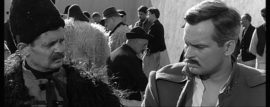
One of the most pleasing aspects of a festival whose program spans some 80 years worth of film history is the sheer diversity of the films you get to see. A typical morning at Il Cinema Ritrovato can have you watching a 35mm projection of a typical Hollywood “programmer”, followed by a beautifully restored digital version of an early Italian feature. A particularly cinephile pleasure that flows from this diversity is how unexpected connections between films can pop up, as was the case with Allan Dwan’s Silver Lode and Miklós Jancsó’s The Round-Up, which I saw in quick succession. As Tom Paulus mentions in his report, Silver Lode demonstrated Dwan’s knack for group staging. In several scenes Dwan crams the academy-ratio frame with actors, lining them up in rows so we can get a good look at each and every one of them in one static shot. This contrasted nicely with Jancsó’s virtuosic roving camera, often picking up one close-up or two-shot after the other in the Widescreen frame, timed perfectly with the intricate choreography of his actors’ movements – a wholly different strategy of shooting group scenes, which is of course tied to a very different view on society, a view in which group dynamics take precedent over individual agency. Again I must recommend reading David Bordwell on the subject. He dedicates a portion of his Narration in the Fiction Film to the construction of space in Jancsó’s films.
Not all accidental pairings make that interesting a double bill however, which takes me back to the example I started with. The early Italian feature I mentioned was Ma l’amor mio non muore! (1913), which featured Italian diva Lyda Borelli (in her feature debut), gorgeous sets and some fanciful staging in depth. Great fun! The B-movie that preceded it was The Most Dangerous Man Alive (1961), Allan Dwan’s take on the typical, late fifties, early sixties Sci-Fi thriller that plays on the fear of nuclear war and is essentially a riff on the classic monster movies, albeit lacking their moral complexity.
Taking some “cinephiliac licence”, The Most Dangerous Man Alive can be tied to Jean Cocteau’s La Belle et la Bête, in its own way a take on the monster movie. The screening of the digital version of the 1995 restoration managed to draw one of the biggest crowd so far (not counting the open-air screenings on the piazza). While the digital print of Cocteau’s classic fairy-tale didn’t exactly win me over – I think Cocteau’s poetry is better served by the vibrancy of film – Henri Alekan’s photography is still nothing less than sublime. I daresay no one who ever saw it can forget the light in Jean Marais’ eyes. Alekan also shot Une si jolie petite plage, Yves Allégret’s revival of poetic realism. But more on that and other wonderful films in a later blog.
PS: For those of you wondering what the Pauli Exclusion Principle is, take a look at this video. Rest assured, I know next to nothing about nuclear physics, so this is just a bit of snobbery on my part. But it does sound great, doesn’t it?